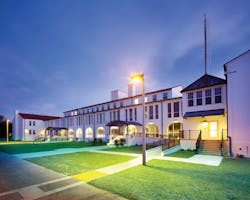2012 Reconstruction Award Platinum Winner: Building 1500, Naval Air Station Pensacola Pensacola, Fla.
Building 1500 at Naval Air Station Pensacola, Fla., was constructed in 1939 as an Army barracks. Over the years, it was renovated a number of times and at one time served as the home of the Navy School of Photography. When funding became available under the American Recovery and Reinvestment Act of 2009, the Naval Facilities Engineering Command put together a design-build best value team to turn the vacant building into NAS Pensacola’s Base Command Headquarters.
The Building Team, led by local firms Caldwell Associates Architects and Greenhut Construction, had to tackle several difficult problems to make the historic building meet current Defense Department standards having to do with anti-terrorism, force protection, blast-proofing, and progressive collapse. Due to its location in a designated high-wind zone, the building also had to meet stringent wind load requirements.
Addressing anti-terrorism, force protection, and progressive collapse
Structural analysis of the exterior walls, which were constructed of terra cotta and finished with cement, determined that they could not meet anti-terrorism/force protection blast requirements or applicable wind-load standards. Given that the exterior could not be touched, AT/FP remedies had to be made from the inside out. The Building Team reinforced the interior face of the wall with six-inch-deep 18-gauge studs anchored into the terra cotta wall. Steel tracks at the base and head of the wall transferred loads into the existing concrete frame.
PROJECT SUMMARY
BUILDING 1500, NAVAL AIR STATION PENSACOLA
Pensacola, Fla.Building Team
Submitting firm: Caldwell Associates Architects (architect)
Owner: Department of the Navy, NAVFAC Southeast
Interior design: Simpson Design Group
Structural engineer: Berube-Leonard
Mechanical/plumbing engineer: MEP Engineering Solutions
Electrical engineer: Klocke & Associates
Civil engineer: Fabre Engineering & Surveying
Fire protection engineer: FireLogix Engineering
Blast structural engineer: Simpson Gumpertz & Heger
General contractor: Greenhut Construction Co.General Information
Size: 69,565 sf
Construction cost: $11,218,898
Construction time: October 2009 to November 2011
Delivery method: Design-build best value
Next, the team took on the replacement of the windows on the exterior walls. Any new windows had to be “historically consistent” with the original double-hung wood sash windows. The Building Team got approval to use aluminum sash windows that matched the sash profiles and glass-to-frame ratios, and a manufacturer (Graham Architectural Products) was able to produce windows that met AT/FP blast-resistance requirements.
Installing the windows to meet AT/FP demands was the next hurdle. Historic considerations dictated that the new windows be installed to the depth of the original windows in the existing masonry openings; however, doing so would not provide sufficient anchorage for blast and wind loads.
The Building Team devised a scheme that involved installing a steel frame and plate system on the interior side of the exterior wall to anchor the windows. They bolted tube steel jamb frames into the concrete frame at top and bottom and welded tube steel head and sill frames to the jamb pieces. Steel plate was welded to these frames to extend into the existing masonry window at the correct depth to allow the windows to be attached consistent with historic standards.
As for progressive collapse, the team determined that conventional steel or concrete reinforcement would be cumbersome and consume valuable space within the building shell, so they went to a carbon fiber reinforcement wrap over the existing concrete frame components, taking care not to allow penetrations into the system from other building infrastructure elements.
Not only is Building 1500 historic in nature, so is the archaeological site on which it sits. Early in construction, when post holes were being dug for the construction fence, the on-site archeologist consultant (required by the Navy) found artifacts of interest.
A full-blown archeological dig would have played havoc with the ARRA-based budget. As an alternative, the team dug “test pits” in a 5x5-meter grid across the site. Only a few areas requiring further excavation were discovered, and the project was able to proceed on schedule.
BD+C Reconstruction Awards Judge Daniel Moser, PE, summarized the project this way: “It was a really unique solution to solving the blast requirements while preserving the historic aspect of the building.” +
